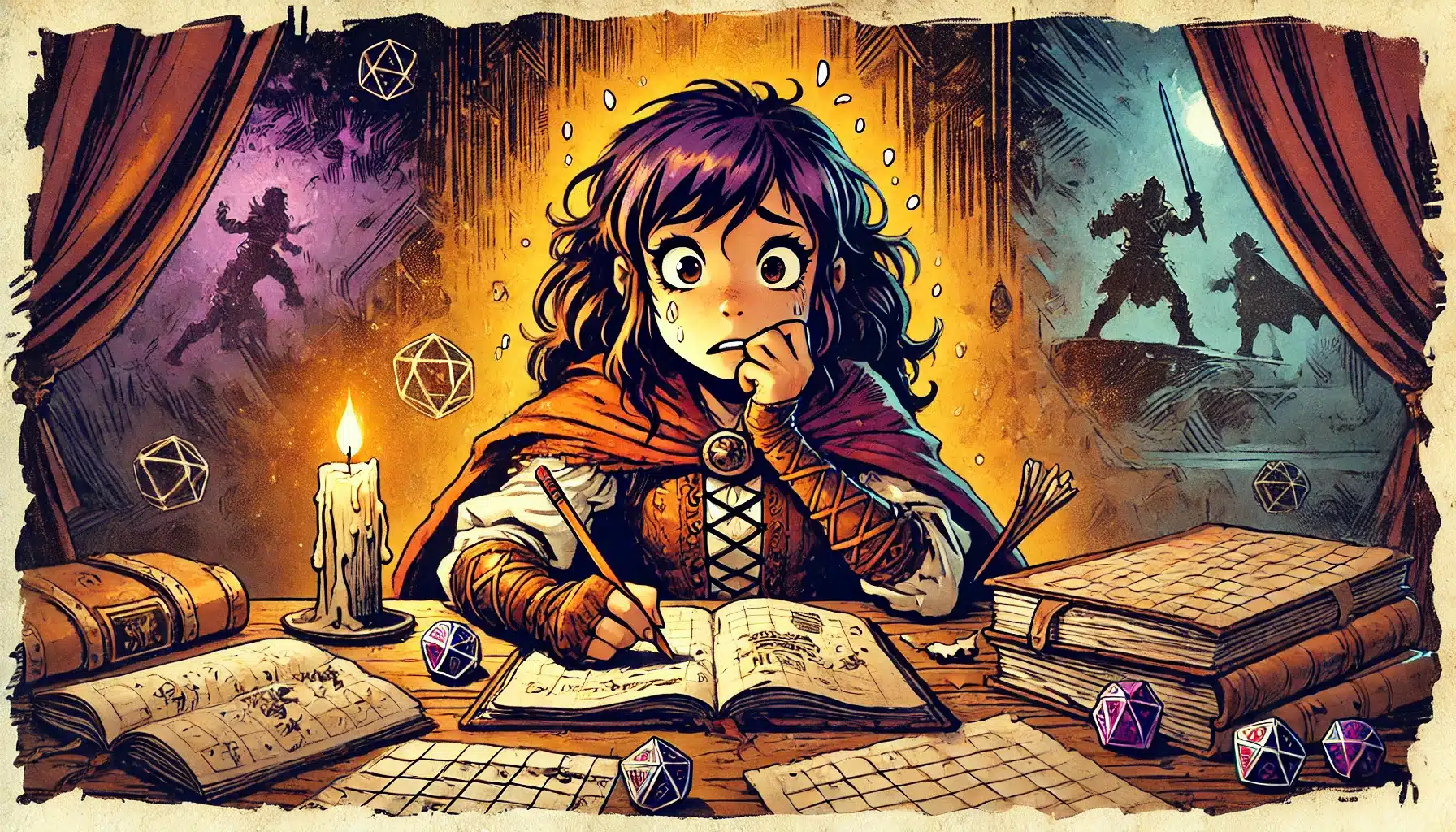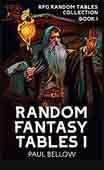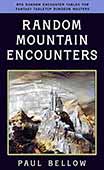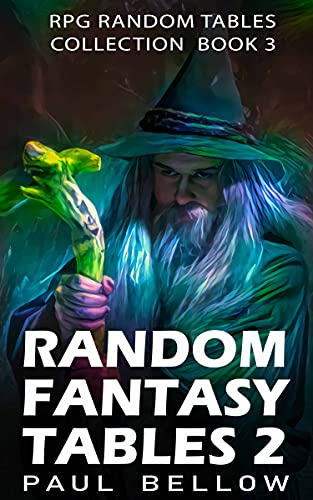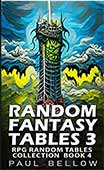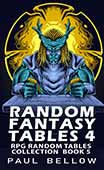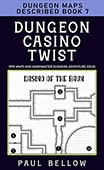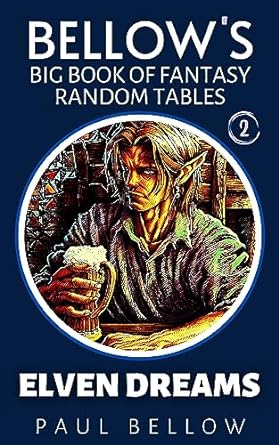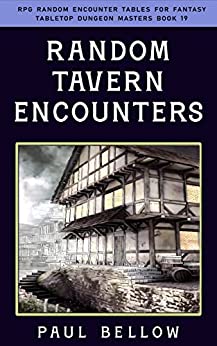Becoming a Dungeon Master (DM) in Dungeons & Dragons (D&D) is an exhilarating yet daunting adventure. Imagine stepping into a universe where your voice becomes the bridge between imagination and reality, where you craft intricate worlds and stories. The very thought of it can overwhelm beginners, for sure. You know, wielding the responsibility of guiding players through the intricacies of a fantastical realm feels monumental at first. However, rest assured, this role is not just about knowledge or experience. At its core, DMing is about storytelling, improvisation, and ensuring everyone at the table has a fantastic time.
The art of Dungeon Mastering is much like orchestrating a symphony—beautiful, complex, but thoroughly enjoyable. Mistakes? They’re inevitable, and trust me, each one is a stepping stone to becoming a better DM. Think of them as part of your learning curve. Even the most seasoned DMs fumble from time to time. And that’s perfectly okay! The beauty lies in embracing these blunders and growing beyond them. The magic of being a DM is in crafting experiences, not delivering perfection.
What makes DMing fascinating is that the game isn’t just yours—it’s collaborative storytelling at its finest. Your players’ actions shape the plot as much as your narration does. As you weave narratives and guide adventures, maintain a mindset that invites creativity and spontaneity. Enjoy the journey as much as the players do. After all, a game of D&D is an ever-evolving tapestry of shared imagination and excitement.
The expectation that weighs heavily on new DMs can sometimes stifle creativity. You might think you need to memorize every rule or possess an encyclopedic knowledge of D&D lore. Thankfully, that’s not the case. Instead, focus on the experience you create. Remember this: your objective is to engage and challenge players, not to defeat them in an adversarial sense. You’re the architect of their adventure, the storyteller, the world builder, and most importantly, the facilitator of fun.
In sum, the role of a Dungeon Master is both a challenge and a joy. Embrace the storytelling aspects, let improvisation flow through your sessions, and above all, prioritize crafting memorable experiences for your players. Mistakes are part of the package, and through them, you’ll grow into a confident and skilled DM.
- Understanding the Basics of Being a Dungeon Master
- Preparing for Your First Session
- Finding the Right Balance Between Rules and Fun
- Running Your First D&D Session
- Setting Player Expectations and Group Guidelines
- Managing Combat Without Slowing Down the Game
- Keeping Players Engaged and Focused
- Handling Common Challenges for New DMs
- Dealing with Uncooperative or Distracted Players
- Improvising When Players Go Off-Script
- Managing NPCs Without Overcomplicating Things
- Expanding Your Skills as a Dungeon Master
- Learning from Player Feedback
- Experimenting with Different DM Styles and Campaign Types
- Using Digital and Physical Tools to Make DMing Easier
- Final Thoughts on Becoming a Great Dungeon Master
Understanding the Basics of Being a Dungeon Master
So, what does a Dungeon Master actually do? At first glance, the DM’s responsibilities may seem like juggling flaming torches while balancing on a tightrope. There’s a lot to manage, undeniably, but breaking it down makes the role more approachable. Essentially, a DM narrates the world—crafting vibrant landscapes, ancient ruins, bustling towns, and mysterious dungeons. Through vivid descriptions and well-timed storytelling, you bring the world alive for players.
Try my AI Tabletop RPG generators...and an extensive library of content!
NPCs, or non-player characters, are another critical aspect of DMing. These are the characters you control to interact with the player characters. They add depth to the narrative, whether they’re allies, merchants, or villains. Your task is to give them life, personality, and purpose within the story. Handling combat is another core duty. As a DM, you orchestrate battles, manage initiative, and ensure that combat runs smoothly and fairly.
But here’s the thing, your ultimate goal isn’t to “win” against the players. Instead, aim to challenge them. It’s about crafting a narrative where players can triumph through wits, teamwork, and courage against the odds. Thus, the balance between storytelling and rules is crucial. Keep the game fun and intriguing; adjust complexity based on your group’s needs.
Engagement is key in your role as a DM. Your job is to keep players invested in the story. Challenge them to think creatively and make meaningful choices. By maintaining a balanced pacing and sprinkling in moments of surprise, you ensure every session is memorable and fun. As the narrative’s conductor, your focus should always be on maintaining an engaging, balanced, and enjoyable experience for everyone at the table.
Preparing for Your First Session
Preparing for your first session can feel like standing on the edge of a vast unknown. Where do you even start? Well, don’t worry— I’ve got you covered. First, choose an adventure that suits your group’s interests and your comfort level. Whether it’s a prewritten module or an original story, make sure it inspires you. Once you’ve picked your adventure, immerse yourself in it. Understanding the plot and key encounters ahead of time helps build confidence.
⚔️ Fantasy RPG Random Tables Books
Make life as a Gamemaster easier…
If you play Dungeons & Dragons, Pathfinder, or other fantasy RPGs, this
RPG random tables series
is packed with encounters, NPCs, treasure, and more. Available in eBook or print—either way, you’ll have a wealth of adventure ideas at your fingertips.
Setting expectations is your next step. Clearly communicate with your players about the tone and style of game you envision. Are you going for a serious, epic saga or a lighthearted romp? Ensuring everyone’s on the same page helps avoid confusion. Then, get comfortable with the rules! You don’t need to memorize every detail but having a good grasp of the basics keeps the game flowing smoothly.
Essential Steps for Preparing a First Session:
- Read the adventure ahead of time: Familiarize yourself with the plot and crucial encounters.
- Prepare quick-reference notes: Highlight essential rules or stats you’ll need on hand.
- Understand player characters: Learn about their abilities and backstories.
- Set clear expectations: Discuss the tone, theme, and boundaries of the game.
- Anticipate player questions: Be ready to clarify rules or setting details.
- Create engaging NPCs: Develop a few key characters to interact with players.
- Establish table rules: Consent mechanisms, PvP guidelines, and phone use policies.
- Plan for surprises: Prepare to improvise if players take unexpected actions.
- Gather resources: Dice, maps, and minis—ensure everything is ready in advance.
- Have fun! Remember that the goal is a fun, shared storytelling experience.
And finally, embrace the unpredictability of D&D. Players may surprise you with their creativity, often leading the story in unexpected directions. That’s the magic of the game. So enjoy the ride, embrace the chaos, and most importantly, savor the shared laughter and excitement that Dungeons & Dragons brings to life.
As you venture into your first session, remember that preparation goes beyond just the game mechanics. It’s about setting a foundation for a collaborative storytelling experience. With careful planning and an open mind, your session will become a cherished memory for all involved.
Finding the Right Balance Between Rules and Fun
New DMs often feel the immense pressure to know every rule, fearing that any lapse in memory or judgment might disrupt the game. But here’s the real deal: you don’t need to stress over what’s written on every page. Strict adherence to rules isn’t always necessary, and sometimes, a well-timed judgement call can make the game flow better. The key lies in knowing when to prioritize fun over rigidity.
There will be times when sticking to the rules is essential, especially when resolving specific mechanics or maintaining fairness. On the other hand, there are moments when using common sense serves better. The trick is finding a harmonious balance between the two. At its core, the primary aim should always be to enhance the players’ experience and overall engagement.
When should you follow the rules to the letter? Primarily during critical sequences where clarity ensures fairness and consistency. In more fluid, character-driven, or humorous situations, prioritize narrative flow. Players will appreciate a DM who fosters creativity and problem-solving, even if that means bending or improvising a rule or two.
Here’s a table to illustrate the different approaches:
| Approach | Pros | Cons |
|---|---|---|
| Strict Rules | Ensures consistency and fairness | Can slow the game, stifle creativity |
| Loose Rules | Encourages creativity, speeds up gameplay | Risks inconsistency, can lead to perceived unfairness |
| Balanced Approach | Flexibility, best of both worlds | Requires judgment, learning curve but it’s worth mastering |
In conclusion, knowing when to follow rules strictly and when to incorporate a bit of theater can create an engaging and dynamic game. Trust your instincts and prioritize the fun and flow of the game. The best sessions often stem from those moments that veer off-script yet create unforgettable stories. So, be flexible, maintain fairness, and above all, don’t lose sight of the genuine joy that lies in storytelling with your friends.
Running Your First D&D Session
Setting the tone for your inaugural D&D session is akin to casting the first stone into a pond—its ripples will influence the rest of your campaign. Your goal? To create a space where creativity thrives, where players feel comfortable letting their imaginations run wild. It can be easy to overcomplicate things, but it’s crucial to stick to simplicity. Especially in the beginning.
The first game should be simple, flexible, and fully focused on player engagement. Keep the plot straightforward. This way, players have the chance to dive into role-playing without being overwhelmed by complex storylines or mechanics. The initial session sets the stage for deeper narratives and strategies later on.
Focus more on making the session enjoyable rather than flawless. Don’t fret if not everything goes according to plan. Be prepared to adapt, improvise, and pivot when necessary. Your main task is to create a collaborative environment where everyone contributes to the unfolding story. Relax, communicate effectively, and most importantly, foster a sense of enjoyment at the table.
Remember, your first game is a stepping stone. It’s an opportunity to get comfortable with the role, to interact with your players, and to map out what works for your group. Learn from each session, and use those experiences to guide your future as a Dungeon Master.
⚔️ Fantasy RPG Random Tables Books
Make life as a Gamemaster easier…
If you play Dungeons & Dragons, Pathfinder, or other fantasy RPGs, this
RPG random tables series
is packed with encounters, NPCs, treasure, and more. Available in eBook or print—either way, you’ll have a wealth of adventure ideas at your fingertips.
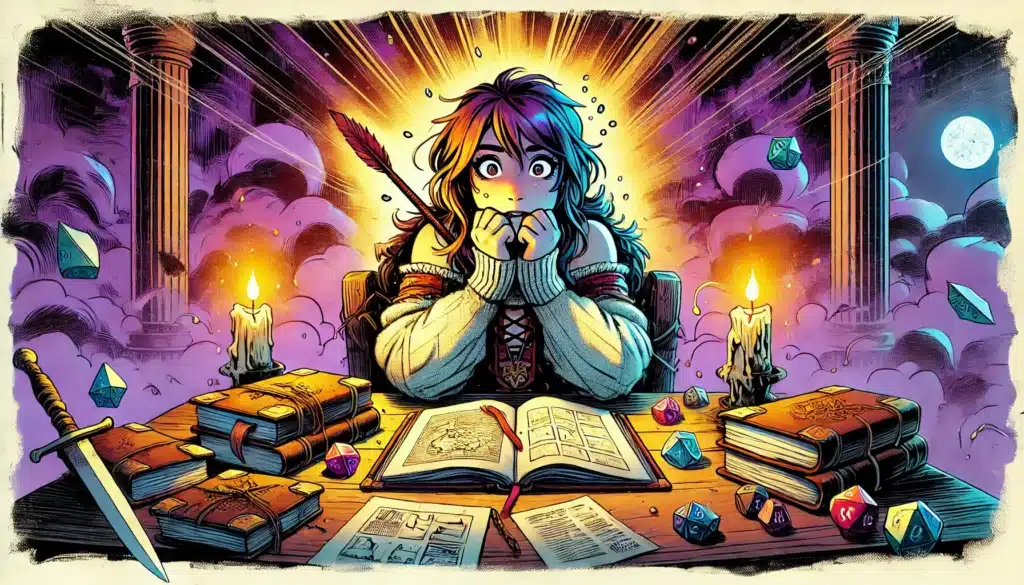
Setting Player Expectations and Group Guidelines
Creating a smooth D&D session involves more than just plot and mechanics—it’s about setting clear expectations and group guidelines. This preliminary step is crucial, as it shapes how you and your players approach the game. Discussing these topics beforehand helps prevent misunderstandings and ensures everyone is on the same page regarding gameplay style.
Begin by talking about the level of roleplay expected. Some players may prefer detailed immersion, while others seek a more casual interaction. Clarifying comfort levels aids in aligning the roleplay experience. Metagaming is another topic worth addressing—encourage players to keep game knowledge separate from character knowledge to maintain an authentic experience.
House rules are your next focus. Every DM has their own set of modifications or unique rules. Communicate these clearly to avoid confusion. These rules may pertain to player-versus-player (PvP) interactions, critical hit mechanics, or even initiative systems. Make sure every player feels comfortable with them.
Conversation Topics:
- Player comfort levels: Discuss roleplaying and interaction expectations.
- Rules on PvP: Determine how player-versus-player conflicts are resolved.
- Handling disagreements: Establish a fair method for resolving conflicts.
- Consent and boundaries: Talk about themes to explore or avoid.
- Table etiquette: Cover distractions like phones, snacks, and off-topic chats.
- Experience levels: Consider tailoring the game for both beginners and veterans.
- Playstyle preferences: Discuss combat vs. roleplay vs. exploration balance.
- Session schedule: Agree on timing and frequency.
- Communication: Determine how to address issues that may arise mid-game.
- Feedback system: Plan regular check-ins to assess what’s working.
By setting clear expectations and guidelines, you pave the way for a game session that’s enjoyable, respectful, and cohesive. Everyone’s on the same team, working towards creating a memorable story together. The dialogue you establish at the start pays dividends in the smooth operation and enjoyment of future sessions.
Always remember, a conversation about expectations and guidelines is more than logistics—it’s the foundation of a collaborative and enriching D&D experience.
Managing Combat Without Slowing Down the Game
Combat in D&D, with its dice rolls and strategy, is both a highlight and a bottleneck. Imagine a scene unfolding, tensions high, and then… everything comes to a grinding halt as rules are double-checked or players take ages deciding on actions. It can siphon the vitality from a session. Combat should be exhilarating, not sluggish. As a new DM, keeping it snappy yet exciting is paramount.
Developing a rhythm for combat helps avert these pitfalls. First, be prepared. Familiarize yourself with the stats, abilities, and actions of monsters before the session starts. Quick-reference sheets with essential information can be a lifesaver. Encourage players to plan their turns in advance, keeping the momentum alive.
Secondly, maintain focus. Opt for descriptive yet concise language to narrate combat, emphasizing key details that evoke excitement. However, don’t get bogged down in minutiae that slow progress. Select calculated moments for dramatic flair—rolls that determine pivotal outcomes can benefit from a bit of storytelling suspense.
Try my AI Tabletop RPG generators...and an extensive library of content!
Lastly, use house rules wisely. Streamlined initiatives, simplified combat mechanics, or using digital tools can keep the game flowing. The aim is to spend more time immersed in the action and less time hashing out rules.
| Pacing | Issues | Fast Solutions |
|---|---|---|
| Slow | Endless dice checks, indecisive players | Encourage advance planning, readiness |
| Fast | Overlooked details, lack of gravitas | Use concise yet impactful narration |
| Balanced | Mix of both issues, find enjoyable rhythm | Combine planning with storytelling flair |
Combat should be a dance, not a dirge. The focus is on maintaining engagement, ensuring everyone has their moment to shine. Explore techniques that streamline gameplay without sacrificing depth, and your players will reward you with enthusiastic involvement.
In quelling the drag of drawn-out combat, you transform it from drudge to drama, where players remain riveted to every dice roll and decision. Balance in pacing is your ally. Study its art, and wield it well.
Keeping Players Engaged and Focused
Imagine this: a session where players shift restlessly, distracted by phones or banter, the narrative momentum dissipating. It’s every DM’s nightmare but one that can be avoided with a bit of juggling, creativity, and improvisation. Keeping players invested isn’t just critical—it’s at the heart of every memorable game.
Pacing is your first tool. Ensure a rhythm that oscillates between high-stakes action and reflective character moments. Giving each player their time in the spotlight keeps them engaged, but it’s not just about spotlight time. It’s about making choices meaningful. Every decision should have an impact, inviting players to invest in the storyline.
The second tool? Relinquishing some control. Embrace the theater of spontaneity when players add unexpected twists. Their choices and creativity lend authenticity and dynamic energy to your narrative. The game becomes a shared space where everyone contributes to the unfolding tale.
Thirdly, employ narrative hooks—cliffhangers to pull them to the edge of their seats and mysteries with breadcrumbs they can’t resist following. Characters they care about, who grow and respond as events unfold, breed investment in outcomes and story arcs.
Ways to Keep Players Engaged:
- Rotate spotlight moments: Ensure each player feels involved and significant.
- Use cliffhangers: Spark anticipation and desire to return to the story.
- Meaningful choices: Allow player actions to have a tangible effect on the world.
- Collaborative world-building: Allow players to help shape aspects of the setting.
- Dynamic pacing: Transition between action, dialogue, and problem-solving.
- Embrace improvisation: Welcome and weave in player innovations.
- Character-focused narratives: Foster arcs that develop their characters.
- In-game rewards: Incentivize engagement with story-driven rewards.
- Personal stakes: Link storylines to character backstories or goals.
- Narrative hooks: Keep players interested with compelling story elements.
Keeping a group entertained and eager requires flexibility and attentiveness. Accept that distractions may arise, and your job is to recalibrate, draw attention back, and refocus the group’s energy on the shared narrative.
By fostering an environment rich with options and opportunities for collaboration, you turn a disparate group of players into a cohesive storytelling engine. That shared experience is what transforms a D&D game into a truly unforgettable journey.
Handling Common Challenges for New DMs
Embarking on your journey as a Dungeon Master can be fraught with challenges—some anticipated, others surprising. Common struggles for new DMs often emerge from the unpredictability of players, mastery of a myriad of rules, and balancing storytelling with gameplay. But fear not; these are stumbling blocks, not insurmountable hurdles.
At the heart of many challenges lies improvisation. Players have an uncanny ability to thumb their noses at carefully planned scenarios, choosing paths unimaginable to your prep work. So, having an improvisational game plan is essential. Flourishing in DMing involves rolling with these punches, rerouting narratives, and weaving player creativity into your world’s fabric.
Another universally daunting aspect for new DMs is mastering the rules. It’s a dense world, this D&D, and you won’t know everything coming out of the gate. So, give yourself permission to learn and grow through each session. Mistakes are your stepping stones to skill.
Balancing challenge and fairness rightly ranks high among difficulties. A fair challenge keeps players engaged, encourages clever problem-solving, and builds memorable stories. A good DM knows when to pull back or push forward, guiding group adventures with player enjoyment at the center.
Overcoming these challenges involves ongoing flexibility, continual learning, and player-focused storytelling. Always remind yourself and your group that at the heart of this adventure is mutual enjoyment—creating worlds and stories that all cherish.
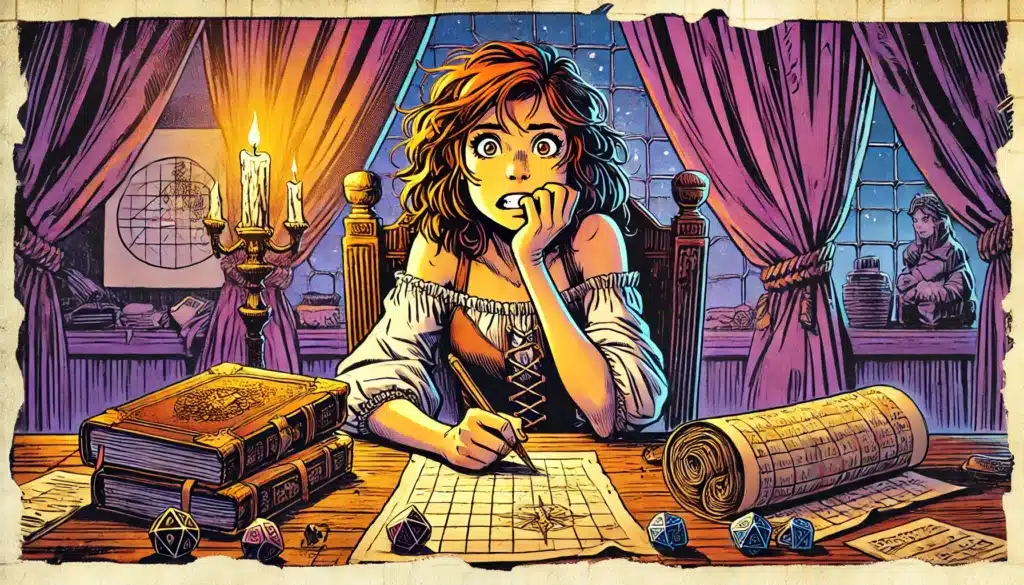
Dealing with Uncooperative or Distracted Players
Every table has its quirks, and you may encounter players whose behaviors challenge your storytelling or disrupt the flow of the game. Navigating these waters requires patience and finesse. Often, a mix of proactive discussion and diplomacy can smooth over the rough patches caused by uncooperative or distracted players.
Rules lawyers, those who meticulously parse every rule, can slow the game’s pacing but often bring a deep understanding of mechanics. Engaging them as allies in maintaining fairness can turn a potential disruption into a valued resource. On the other hand, players who find themselves lost in distractions might need gentle but direct reminders of the game’s collaborative nature and the collective focus required.
⚔️ Fantasy RPG Random Tables Books
Make life as a Gamemaster easier…
If you play Dungeons & Dragons, Pathfinder, or other fantasy RPGs, this
RPG random tables series
is packed with encounters, NPCs, treasure, and more. Available in eBook or print—either way, you’ll have a wealth of adventure ideas at your fingertips.
Handling disruptions often involves setting clear expectations and guidelines, both at the game’s onset and when issues arise. Open communication is crucial. Allow players space to voice frustrations, concerns, or suggestions without fear of repercussion—a platform for dialogue can illuminate underlying issues and foster a healthier game environment.
Lastly, remember that sometimes a gentle nudge or humorous remark can naturally reintegrate stray players back into the narrative’s fabric. A bit of tact, humor, and understanding from the DM often clears confusion and enhances engagement.
| Player Type | Challenges | Strategies |
|---|---|---|
| Rules Lawyer | Focuses on rules over narrative | Encourage them to aid with clarifications |
| The Distracted | Tends to lose focus during sessions | Use reminders of importance, offer engaging plot pieces |
| Overtalker | Dominates conversation or actions | Create balanced participation guidelines, spotlight other players |
| Passive Player | Participates minimally, letting others lead | Encourage character development, provide direct engagement opportunities |
| Argumentative | Challenges every detail, prefers conflict | Address concerns respectfully, establish conflict resolution guidelines |
In handling diverse player personalities, clear communication and setting expectations become pivotal. Conversations around player roles, comfort levels, and guidelines nurture a more inclusive and harmonious gaming landscape.
Recognizing that D&D is a collaborative performance art rather than a solitary pursuit helps new DMs foster group cohesion and shared enjoyment. After all, the aim is a shared journey, full of laughter, camaraderie, and unforgettable stories.
Improvising When Players Go Off-Script
Players notoriously love to exercise their narrative freedom, and more often than not, their decisions lead them off the intended course. The result? DMs find themselves scrambling to adapt on the fly. It’s time to embrace the art of improvisation.
Improvisation isn’t your bane; it’s a skill that, when honed, enriches the gaming experience. Start by planting narrative seeds that allow you to pivot flexibly. Not every path needs meticulous planning! Keep outlines rather than scripts, and prepare adaptable story beats.
Reusing unused content can be your secret weapon. Remember that quirky innkeeper you concocted for a session that never got used? Perfect. Recycle and weave them into the new narrative strand players have chosen. Random tables filled with NPC traits, encounters, or loot can also add richness without the stress of immediate creation.
Let go of the reins and embrace their creativity. Players often bring delightful perspectives and ideas that can lead narratives to unexpected but fantastic places. Utilize their input, reimagining stories in collaboration rather than competition.
Tips for Effective Improvisation:
- Embrace unused content: Recycle material from unused parts of your game.
- Use random tables: Quick reference for NPC traits or encounters.
- Trust player creativity: Allow their ideas to influence story directions.
- Outline over script: Keep flexible plans, enabling on-the-fly pivots.
- Utilize recurring elements: Create continuity through familiar faces or places.
- Prepare generic NPCs: Quick characters ready to populate any setting.
- Use player’s backstory: Integrate their histories into spontaneous plot threads.
- Practice storytelling think-time: Use short pauses to formulate responses.
- Drop hints or questions: Engage players in co-creating narrative elements.
- Lean on mechanics: Let simple checks guide unexpected developments.
Improvisation is a dance between preparation and spontaneity, a delicate balance turning derailed moments into seamless narrative adventures. Embrace the chaos and ride the creative waves—it’s in these unchartered waters that some of the best D&D stories are born.
When players chart unexpected courses, see them not as derailments but as opportunities for unexpected, shared creativity. It’s this collaborative storytelling that makes D&D an experience unlike any other.
Managing NPCs Without Overcomplicating Things
Non-player characters (NPCs) add color, intrigue, and vital interactions to your D&D game. While they are integral to storytelling, new DMs can easily fall into the trap of overcomplicating their creation. It’s possible, and even effective, to craft memorable NPCs without delving into the excessive detail.
An NPC comes to life from a few key characteristics, not a sprawling backstory. Start simple: a unique voice or accent, a singular catchphrase, and a defining personality trait give them depth without overburdening you. NPCs should enhance the game’s fabric, serving the plot or player development instead of merely adding clutter.
Ways to Create Simple yet Engaging NPCs:
- Unique voice: A distinguishing accent or speech pattern sets them apart.
- Catchphrase: A recurring saying makes them memorable.
- Defining personality trait: One core trait that dictates their behavior.
- Distinct appearance: Striking or unusual looks that players remember.
- Role relevance: Ensure they serve an in-game purpose or have connections to player quests.
- Motivation: A clear goal that drives their actions.
- Backstory snippet: A compelling detail hinting at a larger, unexplored history.
- Iconic quirk: An odd habit or talent.
- Relationship map: Connections to other NPCs or player characters.
- Recurring theme: An element or motif tying them to the game world.
Simplicity fosters manageability, and memorable NPCs become touchstones in your sessions. They ought to enrich your stories, acting as allies or adversaries that players feel compelled to engage with.
Always remember that the best NPCs augment and embolden players’ stories. Focusing on a few well-chosen characteristics makes them memorable, without overburdening you with unnecessary detail. You won’t just save prep time—you’ll breathe life into your sessions with strikingly vivid characters.
Expanding Your Skills as a Dungeon Master
Being a Dungeon Master is a continual journey of growth and discovery—one where every session offers new learning experiences and skill-enhancing opportunities. Expanding your skills is as much about reflection as it is about innovation, and avoiding burnout is a dance between rest and exploration.
Invest time in post-session reflection. Consider what worked well and where potential improvements lie. Player enjoyment is your barometer, and their feedback, a treasure trove. Actively seek input from your group to recalibrate future endeavors.
Delve into various play styles, testing new waters by taking on diverse campaign types. Each introduces distinct storytelling approaches and game mechanics, broadening your DM repertoire. Remember, there’s no singular way to be a Dungeon Master—innovation is your ally.
Exploration of both physical and digital DM tools can ease the administrative burden and enhance game fluidity. Jotting down notes in a digital campaign manager, tracking battles via apps, or even crafting maps with software can elevate your sessions, adding clarity and organization.
Improvement and growth as a DM weave through feedback collection, experimentation, and tool adaptation. Keep curiosity at the forefront, ensuring that the journey remains invigorating, and the tales you tell are ever-captivating.
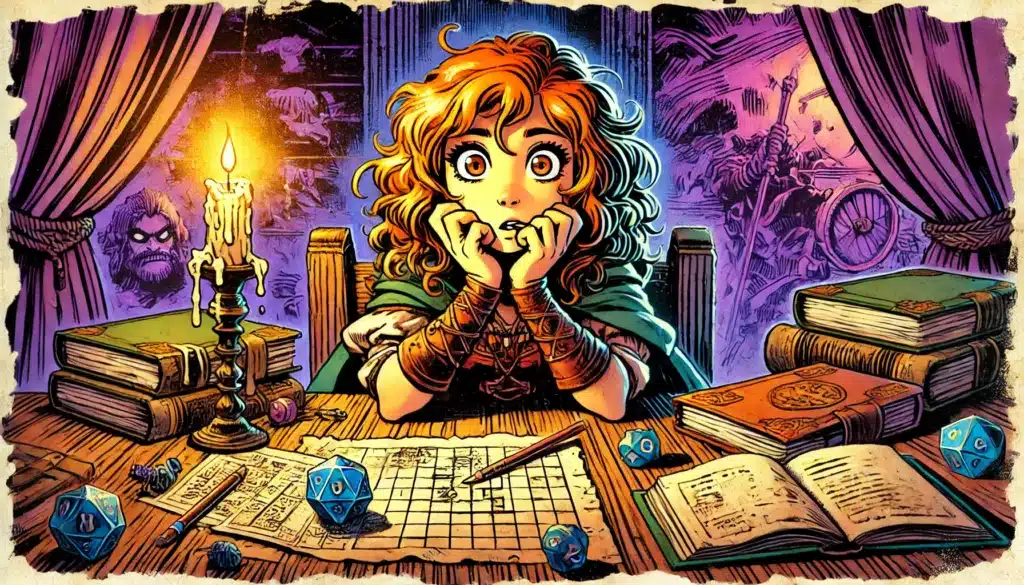
Learning from Player Feedback
In any creative pursuit, feedback acts as a compass guiding progress. For Dungeon Masters, player feedback is invaluable for continual improvement. Think of it as a dialogue, rich with insight, offering perspectives beyond your own. Collect it thoughtfully, and use this resource as a tool to fine-tune your sessions.
To effectively gather feedback, consider when and how to ask players for their thoughts. Timing matters; immediate post-session discussions capture fresh impressions while later reflections might offer depth. Blend both for a comprehensive view.
⚔️ Fantasy RPG Random Tables Books
Make life as a Gamemaster easier…
If you play Dungeons & Dragons, Pathfinder, or other fantasy RPGs, this
RPG random tables series
is packed with encounters, NPCs, treasure, and more. Available in eBook or print—either way, you’ll have a wealth of adventure ideas at your fingertips.
Anonymous surveys can often elicit candid responses players might hesitate to vocalize openly. Encourage honesty and clarity in their answers. Mid-campaign check-ins work wonders, uprooting potential issues before they bloom into bigger distractions.
Strategies for Gathering Player Feedback:
- Post-session discussions: Keep these informal for immediate impressions.
- Anonymous surveys: Offers candid insights without pressure.
- In-game check-ins: Gauge enjoyment levels and adapt on-the-fly.
- End-of-session briefings: Summarize key events, ask for quick feedback loops.
- Pilot a “feedback session”: Dedicate time post-adventure to delve deep into what worked or not.
- Feedback journals: Encourage players to jot down thoughts during gameplay.
- Direct questioning: Ask specific questions about encounters, pacing, or balance.
- Online polls: Provide a quick, at-a-glance view of collective sentiments.
- Observation: Note players’ reactions and body language in real-time.
- Guest DM sessions: Allow players to try the DM role, offering unique insights into their preferences.
The treasure trove of feedback fosters an evolving understanding of your group’s dynamics. Encourage an open environment where players feel their input is valued, and understand that adjustments aren’t signs of failure, but steps toward crafting an experience everyone enjoys.
With feedback in focus, your storytelling and DM skills steadily improve, nurturing sessions that are ever more memorable and immersive.
Experimenting with Different DM Styles and Campaign Types
Just as players have distinct styles and preferences, DMs too benefit from experimentation. Exploring various DM styles opens doors to unique storytelling techniques and game management, expanding both your creative reach and personal enjoyment. It encourages adaptability and nourishes a dynamic campaign environment.
Consider experimenting with different DM styles like storytelling, tactical gaming, or improv-heavy sessions. Each has its own strengths and appeals to varied player types. Storytellers create narrative-rich adventures, weaving lore into every action. Tactical DMs enhance mechanics, focusing on strategic combat and problem-solving. Improv-heavy DMs thrive in unpredictable scenarios, riding the waves of player spontaneity.
Equally, be open to changing up campaign types. From high fantasy to gritty realism, modern-day settings to cosmic horror, each setting brings novel opportunities and challenges to the table. These experiences sharpen your ability to create versatile narratives that resonate with different players. Exploring different campaign types not only keeps the game fresh but also helps you adapt to various storytelling styles and player preferences. For instance, understanding how to run a budget D&D campaign can teach you to craft compelling adventures with minimal resources, emphasizing creativity over expensive materials. By experimenting with different settings and playstyles, you refine your ability to engage diverse groups of players while making the most of what you have.
| DM Style | Strengths | Appeals To |
|---|---|---|
| Storyteller | Rich narratives, deep connections, lore-rich settings | Players who enjoy immersive story arcs |
| Tactical | Detailed mechanics, strategic depth, challenge-centric | Those who relish puzzle-solving, combat and rules |
| Improv-heavy | Flexibility, spontaneous storytelling, player-guided | Creative players, those who enjoy unpredictability |
| Narrative | Character-driven stories, emotional engagements | Character actors, fans of dynamic arcs |
| World-Builder | Intricate settings, detailed environments, realism | Players interested in exploration and detailed lore |
Diversifying your DM approach reinvigorates your sessions, ensuring every game is distinct and fresh. Players are often intrigued by novel narratives, fostering deeper engagement with the setting and characters.
Continuing to evolve and adapt refrains your role from becoming routine. Embracing these variances offers opportunities for personal growth, fostering a dynamic storytelling environment where both DM and players embark on new, exciting adventures.
Using Digital and Physical Tools to Make DMing Easier
In a world where technology coexists with tradition, DMs have access to a treasure trove of tools that aid in running seamless games. Digital and physical tools enhance organizational effectiveness and provide real-time assistance, crafting a more enjoyable experience for both the DM and players.
Digital platforms like Notion act as comprehensive notebooks, offering space to compile campaign notes, character sheets, and world lore. Roll20 and similar online interfaces provide virtual settings where games can be played remotely, with easy access to maps, tokens, and combat mechanics.
Physical tools possess their own charm. Campaign notebooks filled with handwritten musings and sketches convey a tactile connection to your world. Initiative trackers, whether apps or DIY wheels, keep combat flowing without hiccups. Miniatures, maps, and props appeal to visual engagement.
Recommended DM Tools:
- Notion: For organizing notes, sessions, character info.
- Roll20/Foundry VTT: Virtual tabletops for remote play.
- D&D Beyond: Digital character management and reference.
- Dice Rollers: Physical or app-based for convenience.
- Initiative Trackers: Apps or DIY to manage combat order.
- Campaign Notebooks: Classic, handwritten entries for a tangible feel.
- Map Makers: Software like Inkarnate or Dyson Logos’ tools.
- Scene Soundtrack Apps: Create ambiance and themes.
- Props & Miniatures: Enhance immersion with tactile elements.
- Text/Chat Apps: Keep track of player interactions and feedback.
By integrating these tools into your DM repertoire, you’ll simplify gameplay management, leaving more room for storytelling and improvisation. Balance the modern digital flair with the classic joys of tangible engagement. Both enhance the shared adventure, allowing the focus to remain on dynamic storytelling.
Tools, whether digital or physical, serve as your trusted allies in crafting unforgettable D&D experiences. Discover the combination that works best for you, and watch your game sessions evolve in enjoyment and depth.
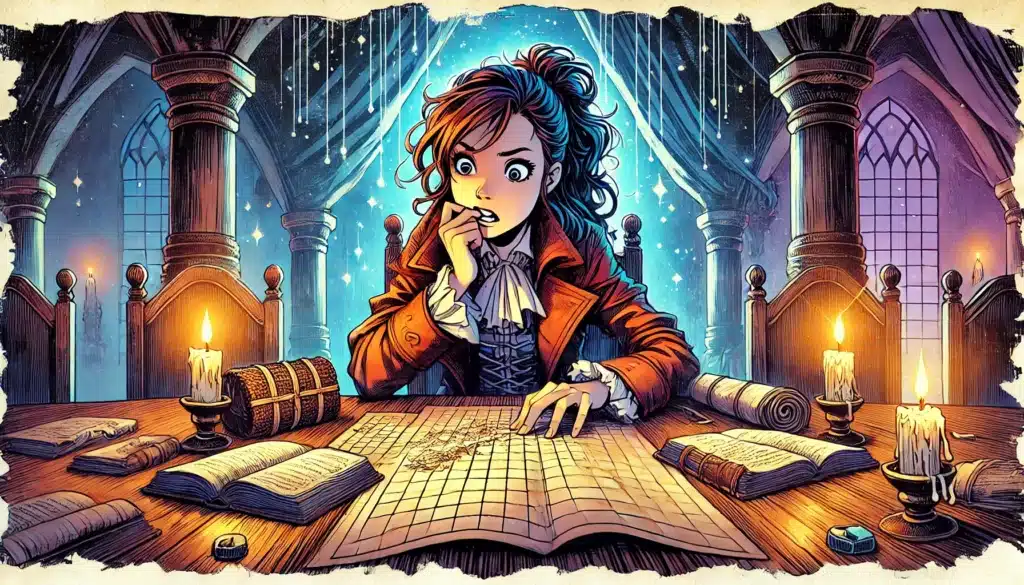
Final Thoughts on Becoming a Great Dungeon Master
Becoming a great Dungeon Master is less about inherent genius and more about growth, experience, and heart. Every campaign is a stepping stone on the journey. As exciting as it is challenging, DMing isn’t about achieving flawlessness but about fostering unforgettable experiences. Embrace your mistakes—each misstep is but a stair on the staircase to mastery.
Try my AI Tabletop RPG generators...and an extensive library of content!
Focus on prioritizing player enjoyment. The stories unfold not just from your plans but from the players’ desires and actions as well. Aim to craft sessions rich with participation, intrigue, and camaraderie. These are the traits that keep players eager to return to your table.
Confidence grows gradually with every roll, every decision, every session. You’ll find that what began as nerves transforms into rhythm and flow. The table becomes a dance floor where rules and creativity intertwine, a space where each player adds to the symphony of your session.
Remember, the heart of DMing is fun. Whether navigating rule intricacies or spinning delightful chaos from player choices, your mission is crafting joy from the collaborative storytelling venture. Those moments of triumph, surprise, and shared laughter are the core of what makes D&D, and your role as a DM, truly magical.
Ultimately, as you learn, your personal style will emerge, molded by experiences and shared by enthusiastic players. The journey into Dungeon Mastery is a multi-chapter saga, each part brimming with opportunity and enchantment. Embrace it fully, and both you and your players will forge stories worth remembering.

